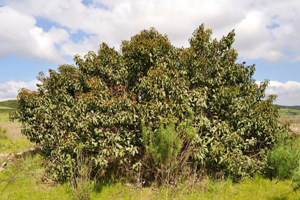Malosma is a plant genus with only one species, laurina. It was formerly known as Rhus laurina . Avocado and citrus growers use natural stands of laurel sumac to indicate favorable frost free zones. Malosma laurina is native to the U.S. and is in the Anacardiaceae (Sumac Family).
Photo Credit: © Brandt Maxwell
Malosma laurina
Common Name: laurel sumac
Plant Functional Group: Evergreen broadleaf
Class > Order > Family: Magnoliopsida > Sapindales > Anacardiaceae
What does the species look like?
Malosma laurel is a rounded, evergreen, perennial shrub or tree that grows to 15 feet. Laurel sumac is often found as a large thicket with a spreading crown. Its bark is smooth and grayish-brown, its leaves are a glossy green with reddish veins, and its stems are red. Its small, fragrant, white flowers appear in large, tight clusters that look somewhat like a lilac flower. The fruit is a smooth white drupe with a hard-coated seed and appears in clusters.
Malosma laurina occurs only along the southern coasts of California, below 3,000 feet, on dry ridges and canyons in chaparral, coastal sage scrub, and oak woodland communities. It is drought resistant but not frost tolerant.
Malosma laurina attracts birds and songbirds that eat the fruit. Deer and other mammals lightly eat seedlings and the fruit of laurel sumac. Insects enjoy the fragrant flowers. Some people in frost-free zones use this shrub as a landscape plant.
Where is the species found?
States & Provinces
CA
Special Considerations for Observing
1. If drought seems to be the cause of leaf color or fall for a plant, please make a comment about it for that observation.
Which phenophases should I observe?
Do you see...?
Leaves
Breaking leaf buds More...
How many buds are breaking?
Less than 3 3 to 10 11 to 100 101 to 1,000 1,001 to 10,000 More than 10,000
Young leaves How many young leaves are present?
Less than 3 3 to 10 11 to 100 101 to 1,000 1,001 to 10,000 More than 10,000
Flowers
Flowers or flower buds More...
How many flowers and flower buds are present? For species in which individual flowers are clustered in flower heads, spikes or catkins (inflorescences), simply estimate the number of flower heads, spikes or catkins and not the number of individual flowers.
Less than 3 3 to 10 11 to 100 101 to 1,000 1,001 to 10,000 More than 10,000
Open flowers More...
What percentage of all fresh flowers (buds plus unopened plus open) on the plant are open? For species in which individual flowers are clustered in flower heads, spikes or catkins (inflorescences), estimate the percentage of all individual flowers that are open.
Less than 5% 5-24% 25-49% 50-74% 75-94% 95% or more
Fruits
Fruits Malosma laurina , the fruit is berry-like and changes from green to whitish.More...
How many fruits are present?
Less than 3 3 to 10 11 to 100 101 to 1,000 1,001 to 10,000 More than 10,000
Ripe fruits Malosma laurina , a fruit is considered ripe when it has turned whitish.More...
What percentage of all fruits (unripe plus ripe) on the plant are ripe?
Less than 5% 5-24% 25-49% 50-74% 75-94% 95% or more
Recent fruit or seed drop More...
How many mature fruits have dropped seeds or have completely dropped or been removed from the plant since your last visit?
Less than 3 3 to 10 11 to 100 101 to 1,000 1,001 to 10,000 More than 10,000
What do these phenophases look like?
There is currently no photoguide available for this species. If you'd like help us create one, use the guidance document and species template provided here . Then send it via email to education@usanpn.org when it is complete.
